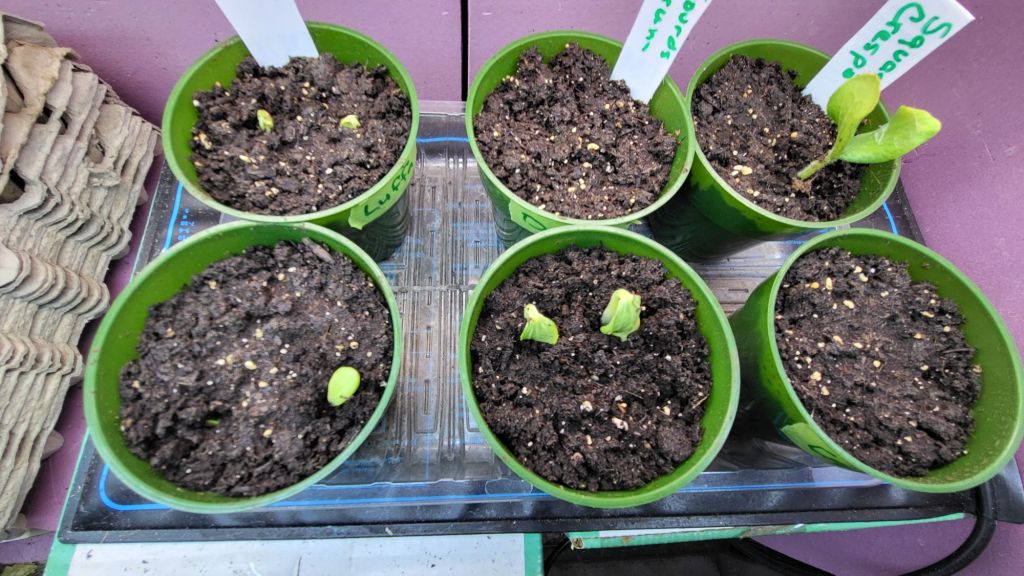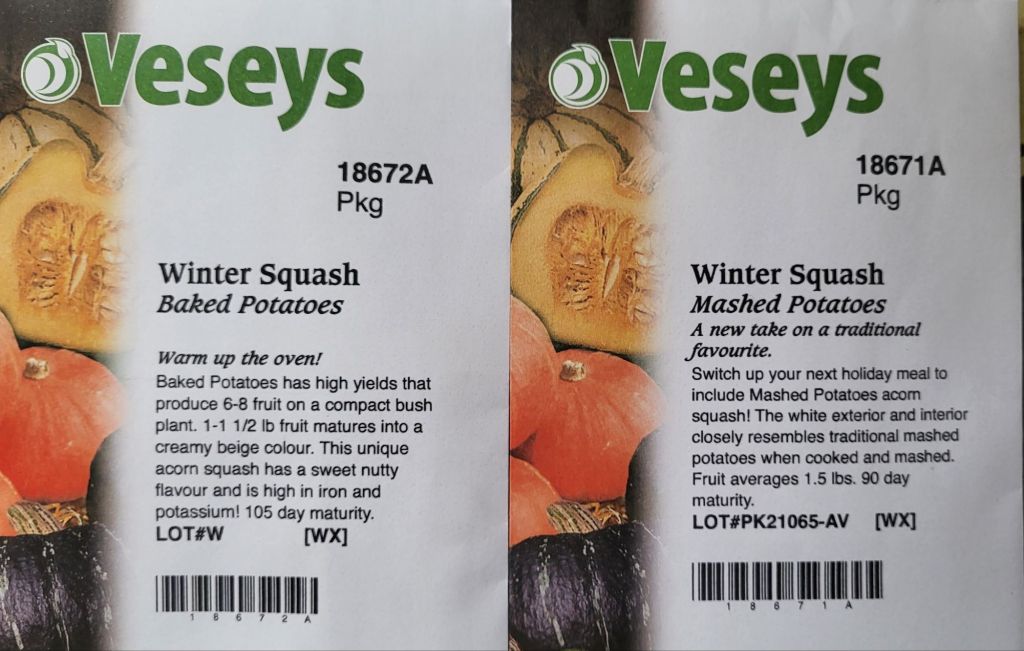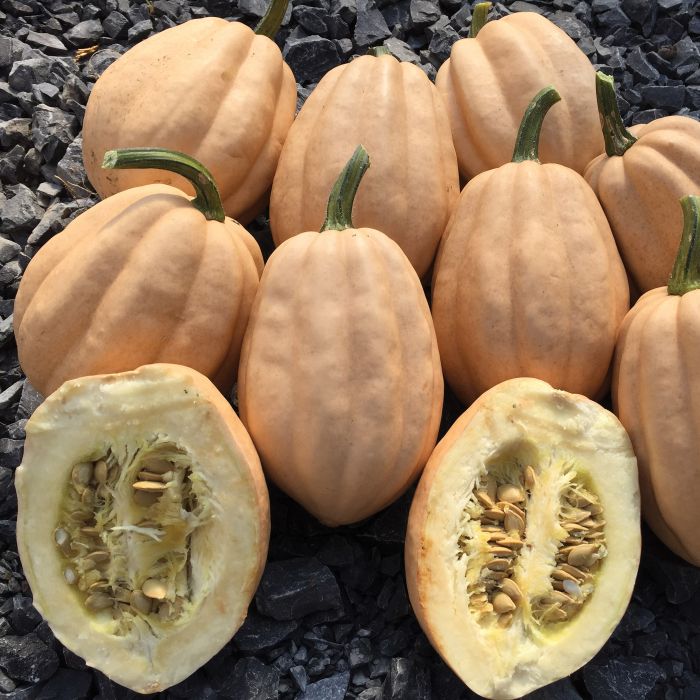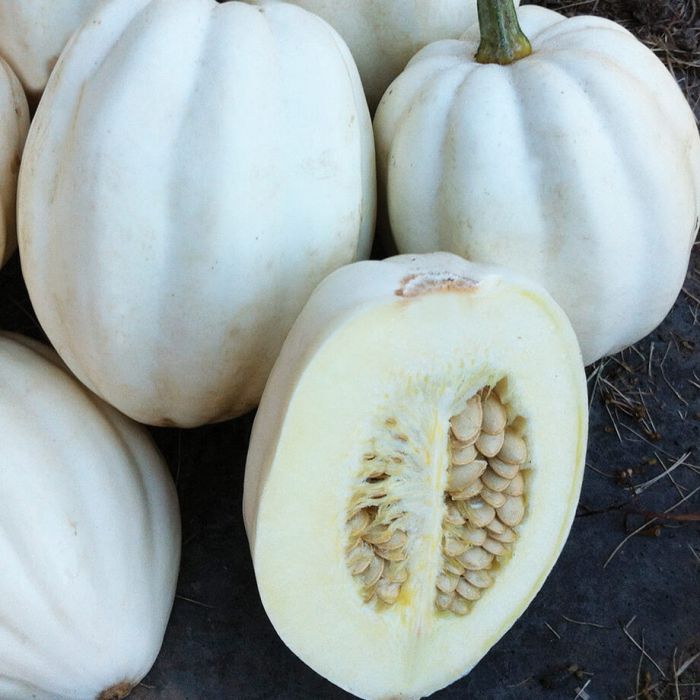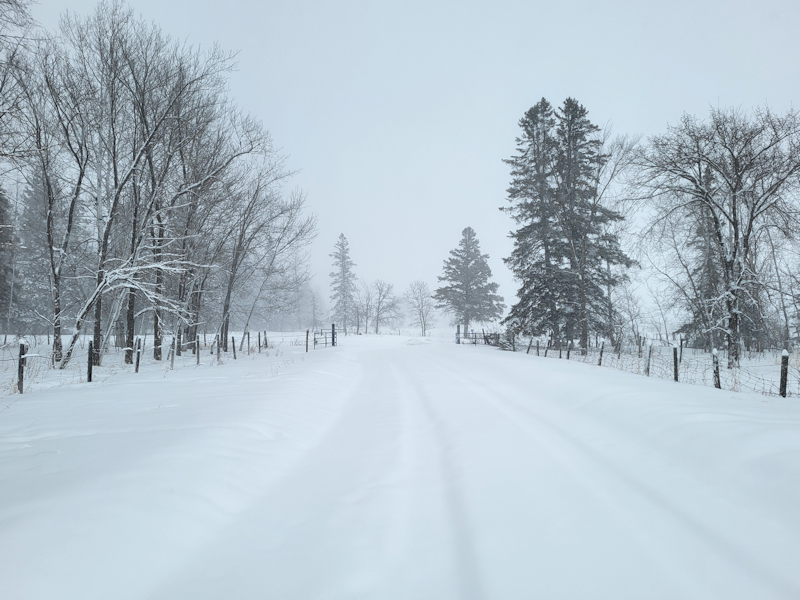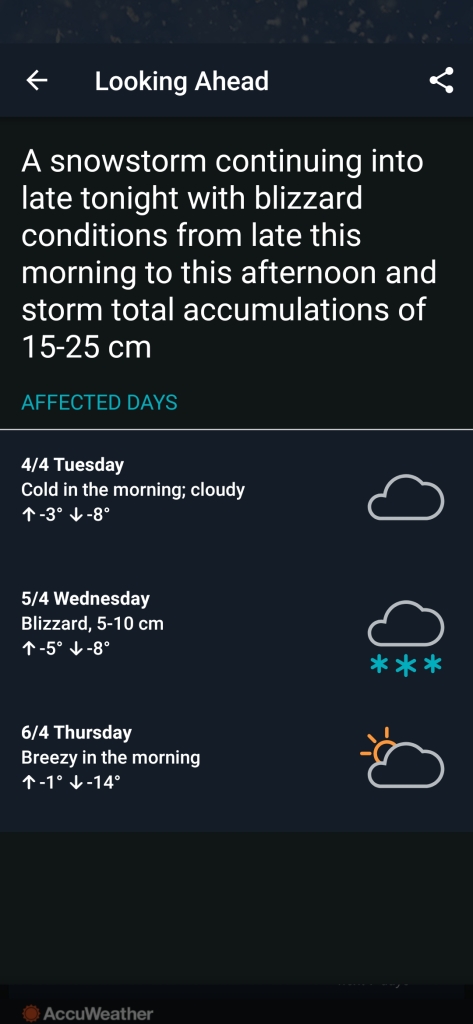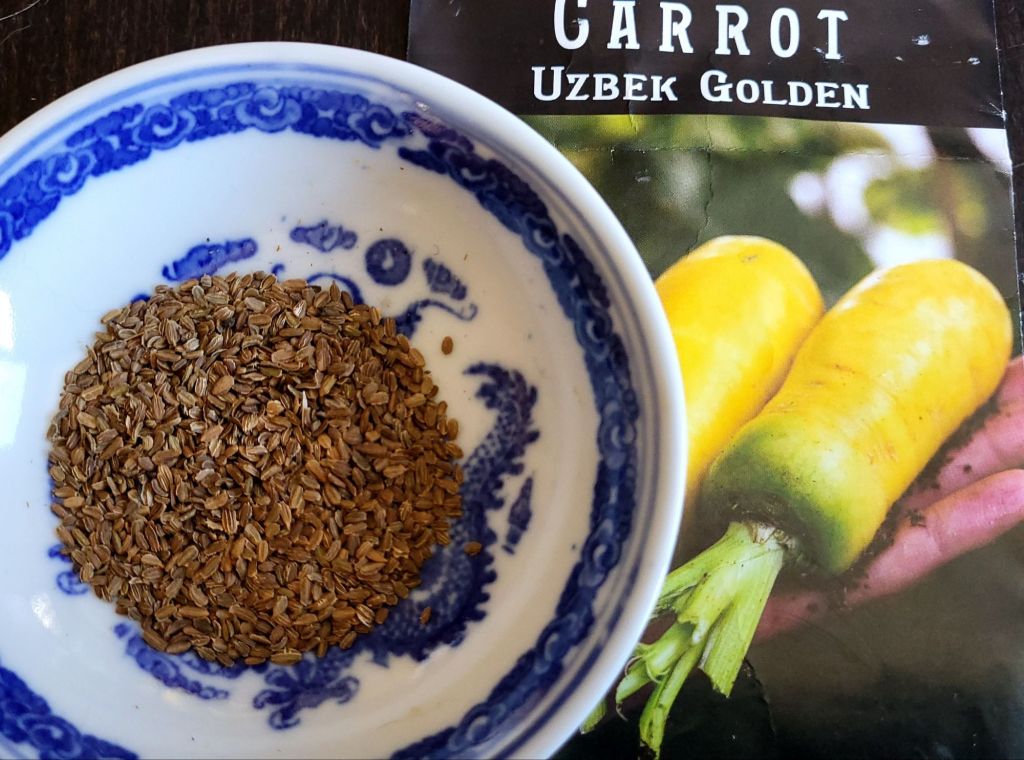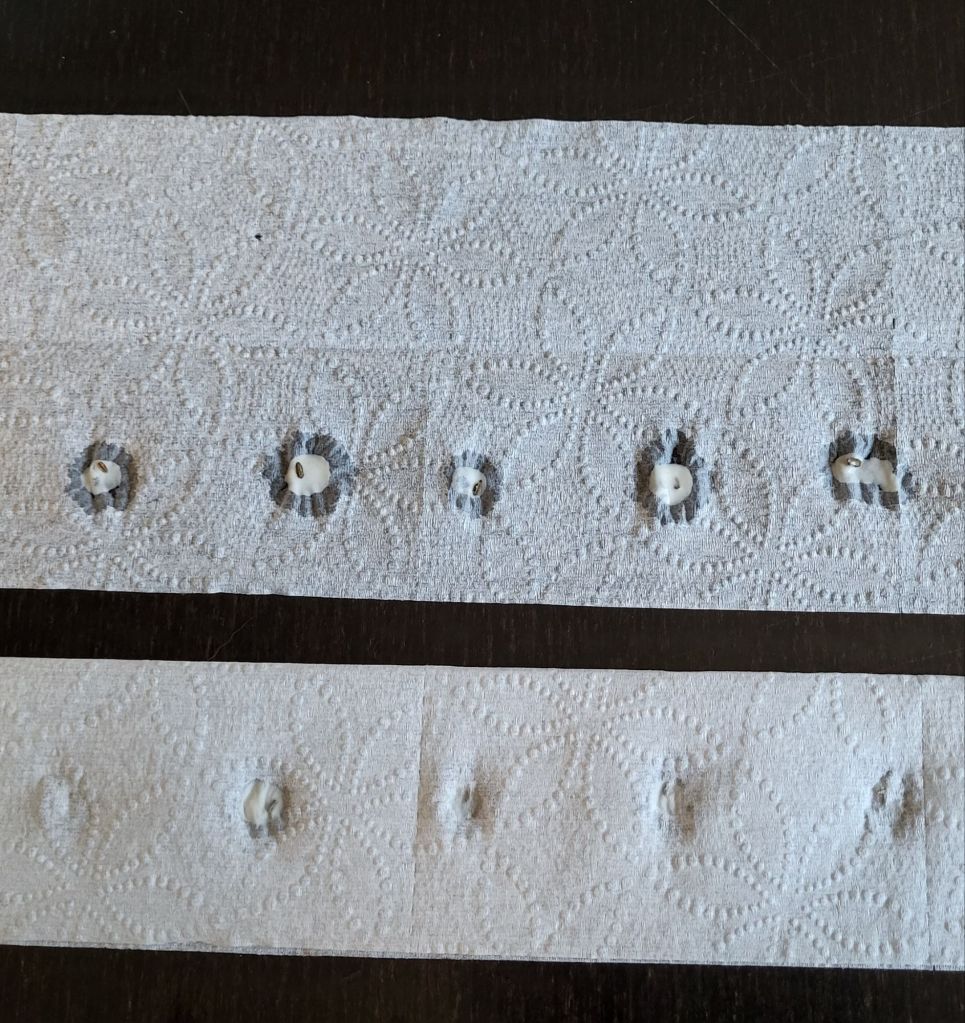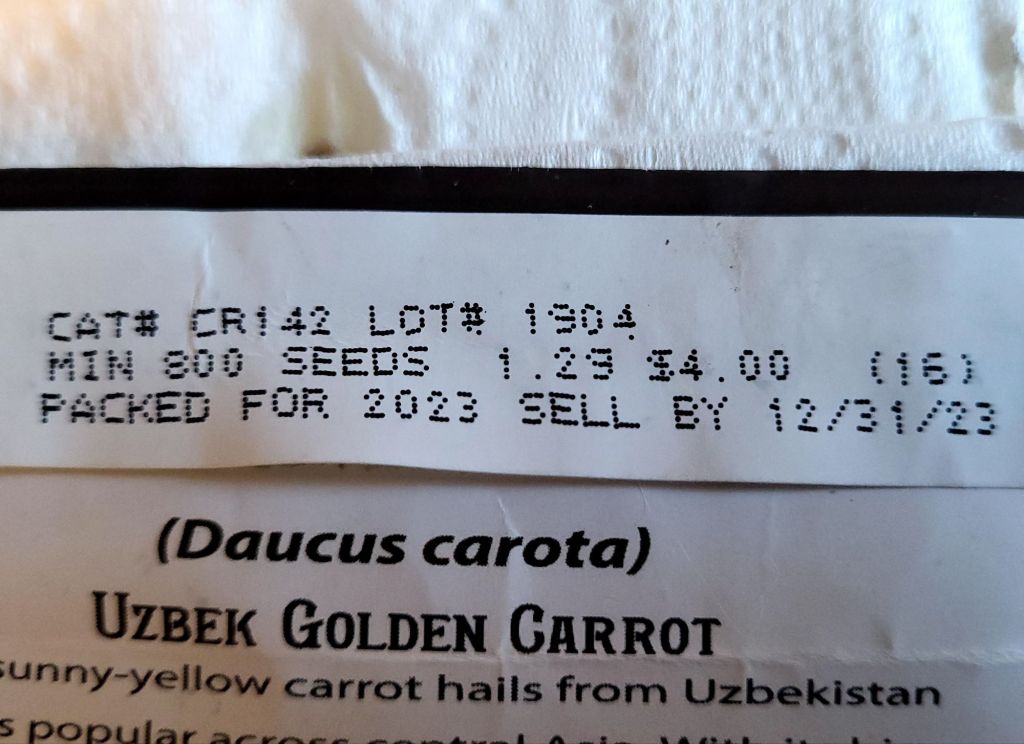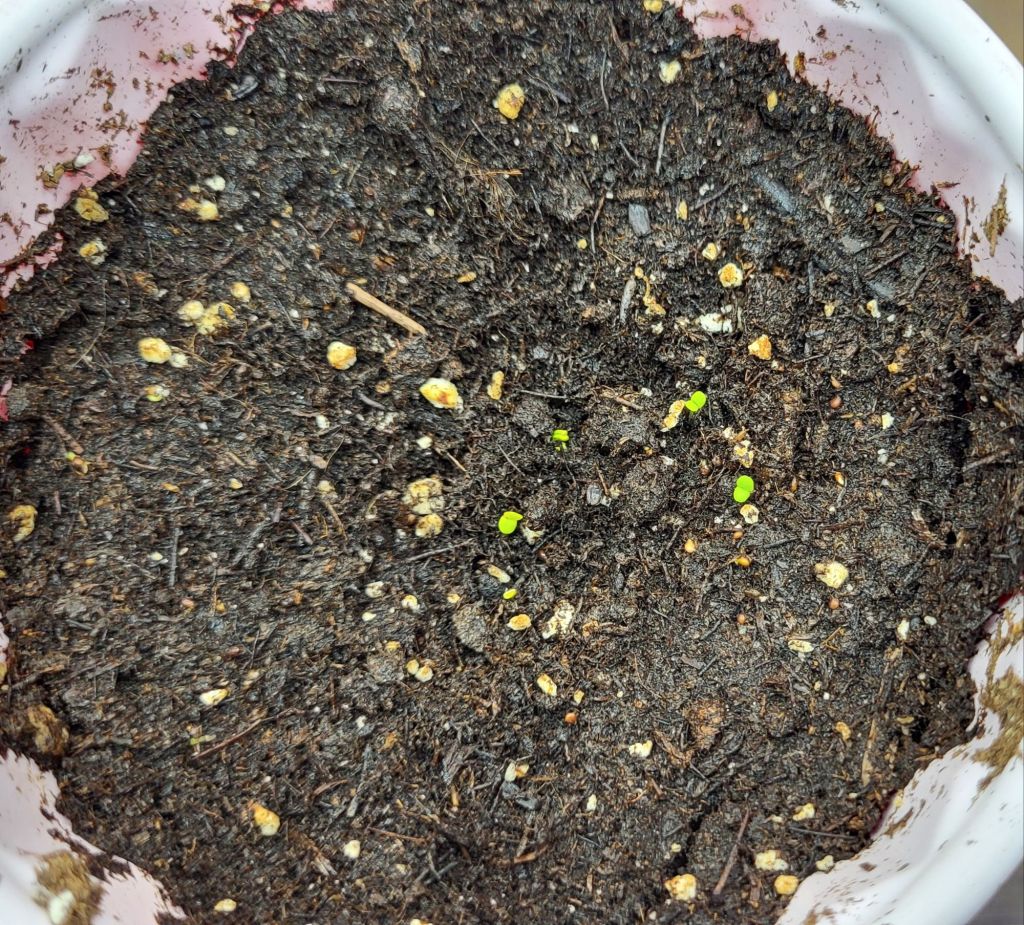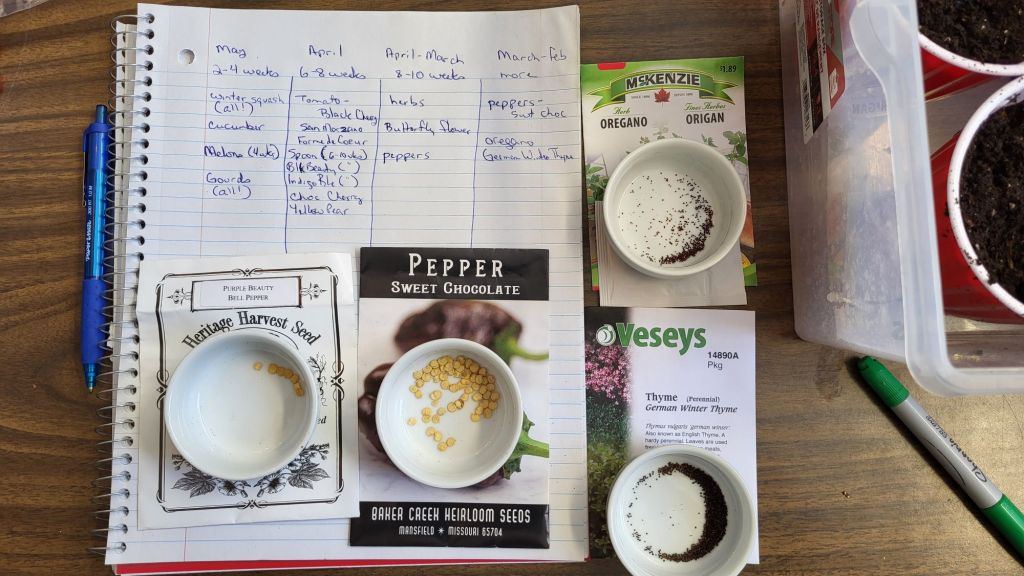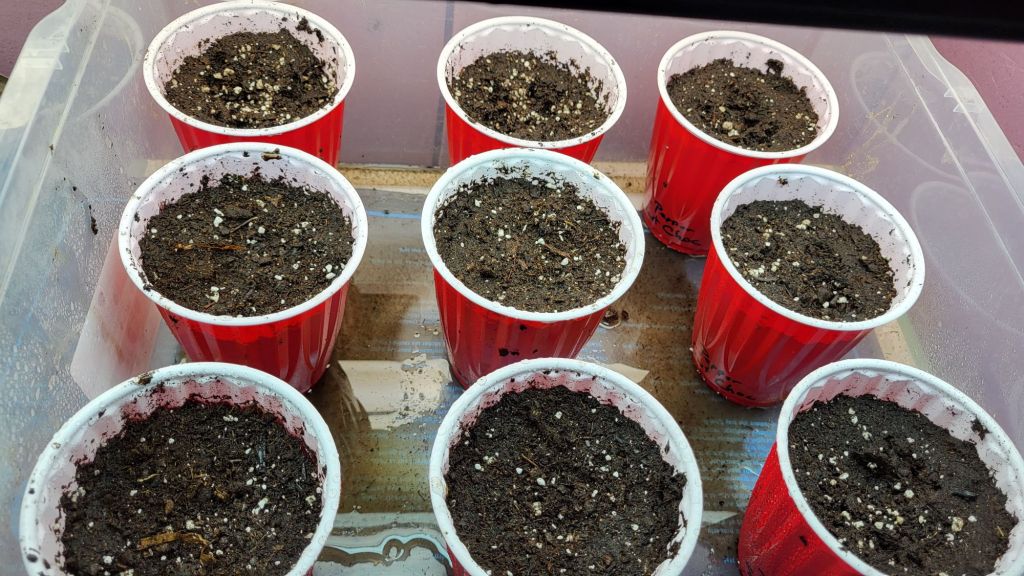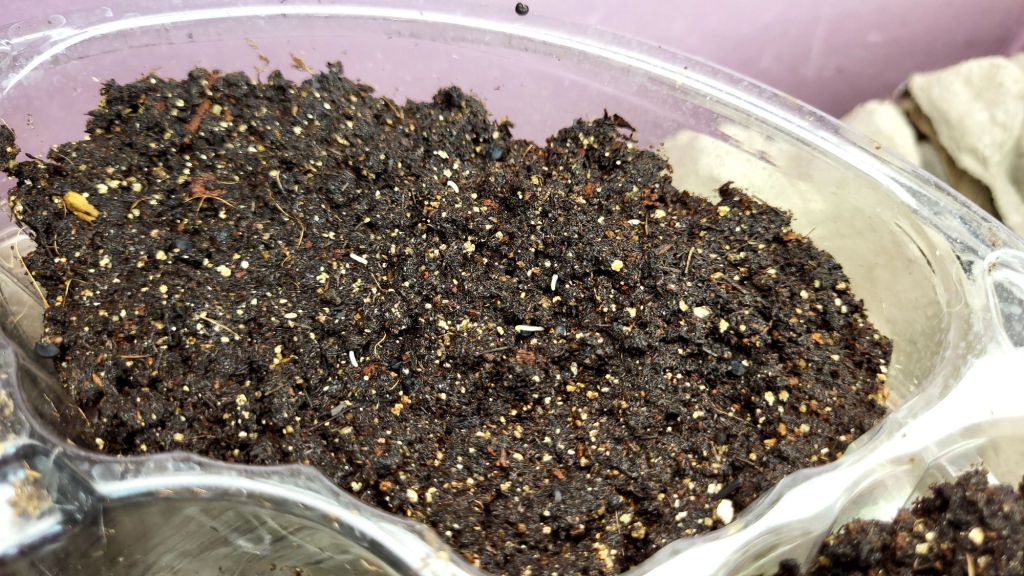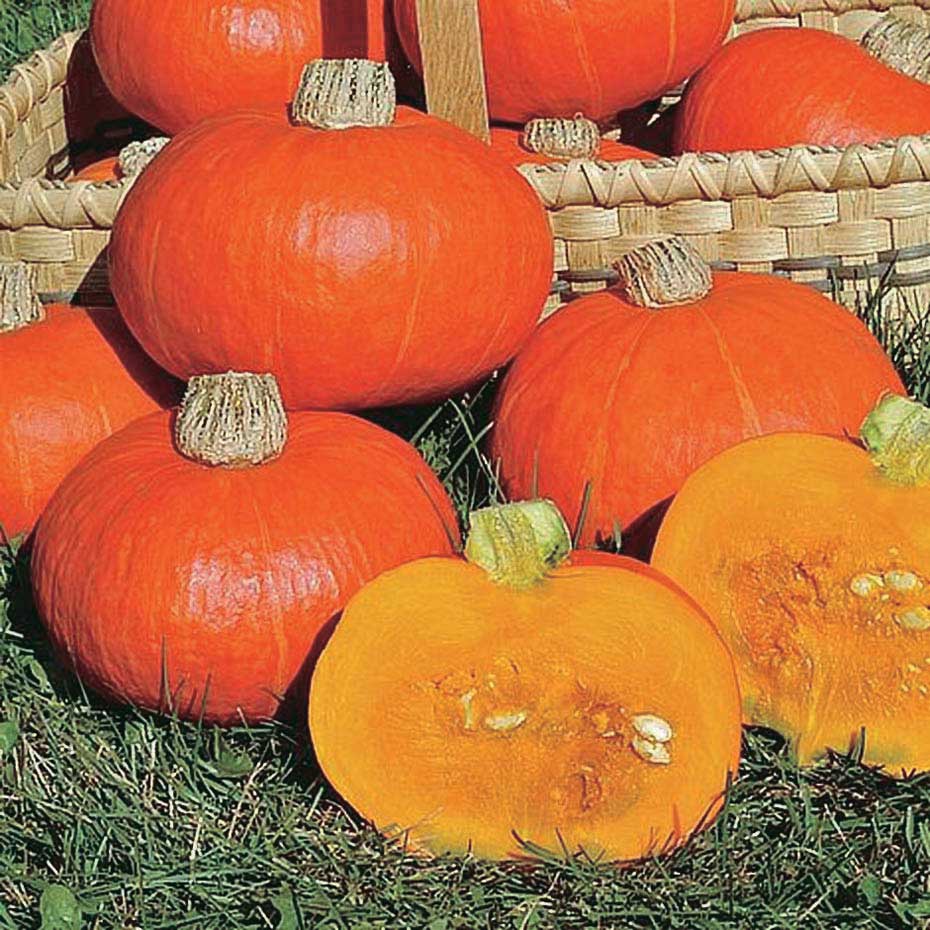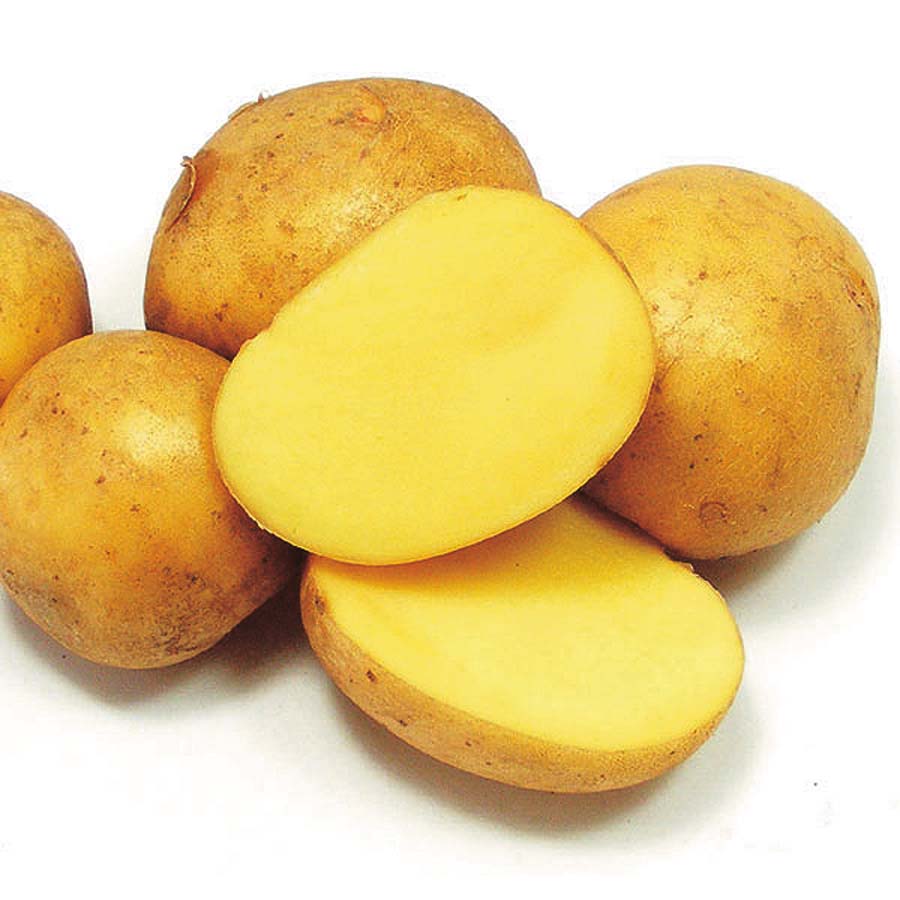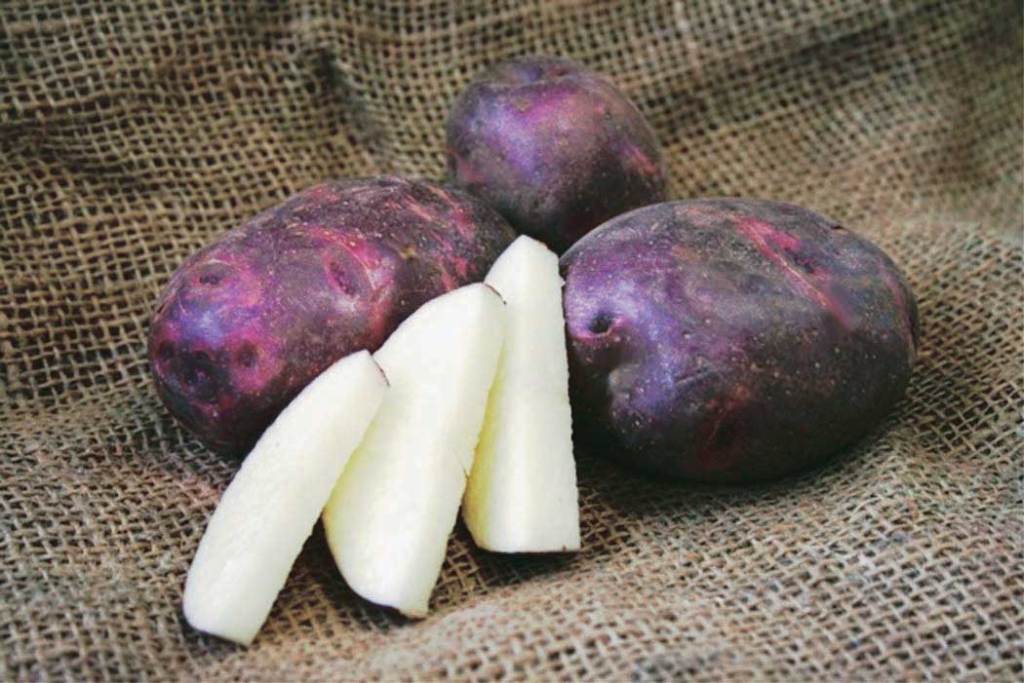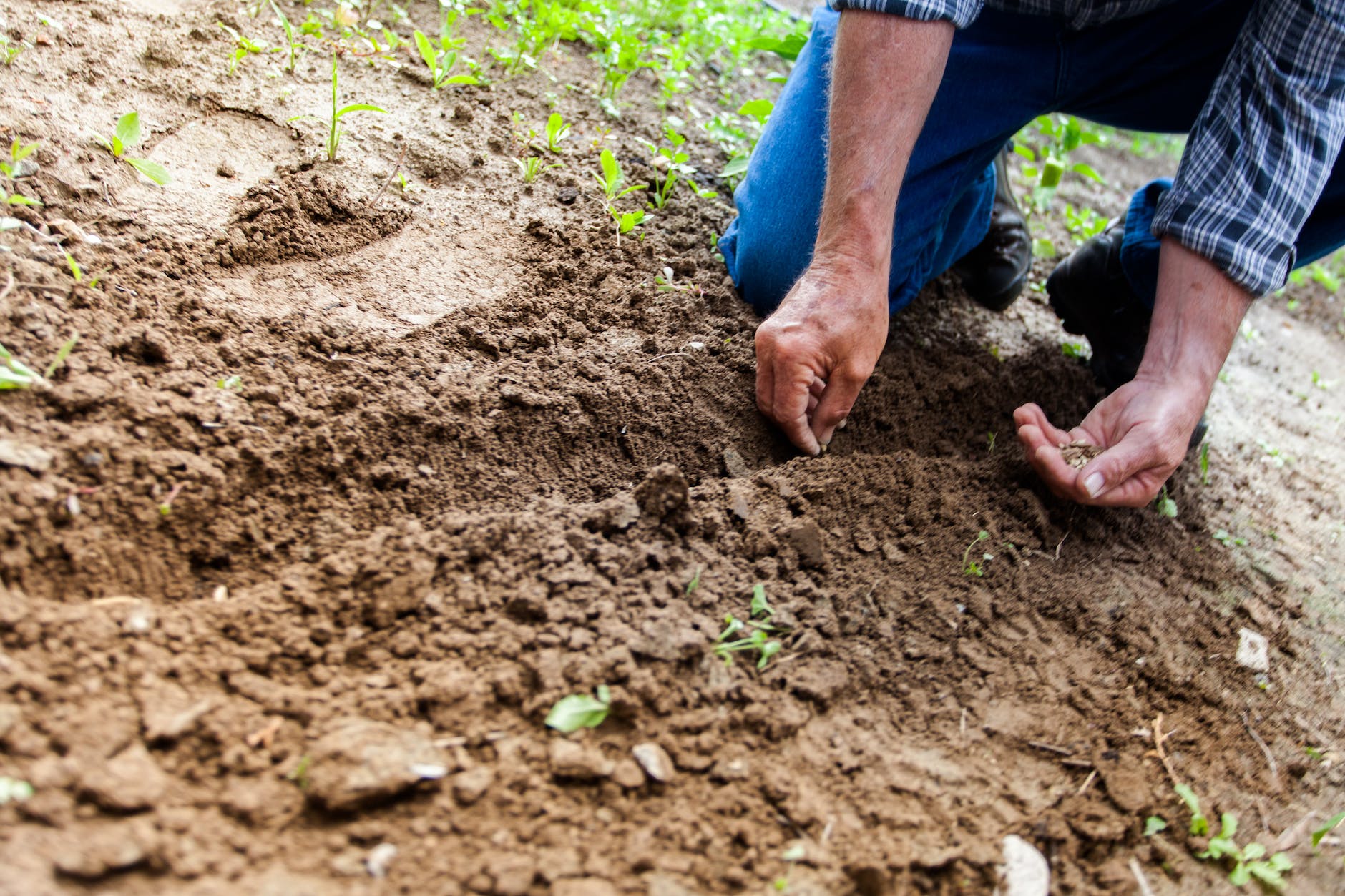Okay, now that we’ve gone though and analysed how our garden did in 2023, it’s time to use that information to review and reset our plans for our 2024 garden.
For the past few years, we’ve done a lot of experimenting. We will continue to experiment, but some things will be set aside for now, to try again later.
So let’s go through the different categories again.
Fall garlic, perennials and food forest items
Our fall garlic is already planted. This year, we’re just doing one variety, so we got 3 pounds of garlic and they’re planted in locations, in the old kitchen garden. Hopefully, they will survive the winter in their raised beds, and we’ll have a good harvest out of them. Garlic will be a staple crop. We might still try other varieties to find which one we like best but, at this point, it’s more about figuring out how much to plant to meet our needs.
We’ve also got the unexpected purchase of saffron crocuses planted already. I’m quite excited to see how they do. They’re zone 4 and got extra protection for the winter, but our winter has been so mild so far, they should do just fine.
Berries, fruit trees and expanding the food forest
What we do next here will depend on our budget. With fruit and nut trees, they really should be planted as early as we can get them, since they can take so long before producing. We still need to get more sea buckthorn, since we lost 3 out of a bundle of 5. We got two tiny Trader mulberry along with our Liberty apple tree. They didn’t have stock of the usual sizes they ship, so instead of one 2 yr seedling, we got two 1 yr seedlings. Those were so small, we ended up keeping them indoors. They’ve grown quite a bit and, as I write this, they have gone dormant for the winter. Hopefully, they will start budding in the spring, as we harden them off before transplanting outdoors.
We might get another, hardier variety of apple tree, but we also need to keep in mind that almost all the crab apples we have now are dying of a fungal disease, and once that gets in the soil, there’s no getting rid of it. We’re looking at hardy plum and pear trees, but I’m also keen on getting things like hazelnuts, butternuts or black walnut trees. The hazelnuts bushes, at least, will start producing in 3-5 years, unlike the much longer time needed for the bigger trees.
We have black currants that need to be transplanted out of the shady area they are in now, and the haskap probably need to be transplanted, too. They have yet to produce.
Saskatoons are on our list, as are gooseberries.
More raspberries are definitely on the list. The goal is to have different varieties that mature at different times, so extended harvesting.
I would like to get more strawberry transplants and use them as a ground cover under food forest transplants. Those are something that should to be replanted elsewhere every few years, so that would work out.
We intended to get green asparagus and more purple asparagus, in alternating years, but we are having trouble figuring out where to plant something that we can expect to produce for 20 years, so that will wait.
No change on the sunchokes. They’ll take care of themselves at this point.
We also need to figure out where to plant annuals that we can treat as perennials that we didn’t plant in 2023, like strawberry spinach, dill and other varieties of bread seed poppies.
We also need to get native wildflowers to attract pollinators growing. Those will be scattered about, and bordering other areas.
Root vegetables
Potatoes will, of course, be grown again. I just don’t know where, yet! While I like the fingerling varieties, I don’t like fussing with smaller potatoes as much, so I think this year I will focus on just two basic varieties, one a white or yellow potato, and one a red potato. Scab resistance and storability will be the main factors to consider when choosing varieties.
I think we’ll need to skip beets and turnips for a few years. I’d still like to grow a couple of radishes for their pods but, so far, none have had a long enough growing season to reach that stage, so it might be skipped. We might still grow a few radishes for their roots, for those family members that enjoy them.
Carrots, however, have done well, so we’ll keep growing those for sure. I can’t remember if I still have Uzbek Golden carrot seed left, but do want to grow those again. The only down side is that I haven’t seen a Canadian supplier, and the cost of ordering from the US is getting too high. I’ve got lots of seed for other varieties, though.
Onions and Shallots
These will continue to be staples, even as we try different varieties to see what works. I’ve just got seeds for yellow globe onions and pink shallots in, plus I need to get seeds for a red variety. It’s yellow onions we use the most, so finding something that grows well here, and stores well, is the priority over other types.
Tomatoes
We had so many tomato starts in 2023, and not enough space to transplant them!
While we liked the black varieties we experimented with, my daughters have suggested that for 2024, we stick with just one fresh eating variety, and requested it be a grape or cherry tomato type. Besides that, we will try a different paste tomato variety. Something more resistant to blight!
When cleaning up the old kitchen garden, the Spoon tomatoes still had some ripe tomatoes on them, so I just stuck those into the ground after pulling up the plants. Who knows. We might have some self seeded Spoon tomatoes next year!
Corn, peas and beans
I want to grow peas again, but would like to try them somewhere else. We have yet to have really healthy pea plants, even though we’ve managed to have some to harvest. Deer eating them is only part of the problem!
With beans, I still want to try the varieties we didn’t manage to plant in 2023, with both bush and pole bean varieties, plus dry bean varieties. If we have the space, I’d like to try the seeds I’d harvested from the self seeded varieties that grew in our compost pile. I still haven’t been able to figure out what they are, or where they came from!
As for corn, I think we’ll save experimenting with popcorn again for another year. Likewise with the purple corn. I want to focus on growing sweet corn. We have a couple of short season varieties that didn’t get planted in 2023, so I want to grow at least one of those, and a decent amount of them!
Peppers, herbs and greens
For the sweet bell peppers, my daughters have suggested we just do one variety, and they don’t particularly care what kind. They find they all seemed to taste the same. I do have a request to grow hot peppers, too. We still have plenty of seeds to choose from.
For herbs, it should be interesting to see what makes it through the winter. Did the chamomile self seed? Will the thyme make it? I normally would expect the spearmint to survive, but they’re in a pot, not in the ground, so they will likely not survive the winter. We will likely find other varieties of herbs to grow, as we convert our old kitchen garden into mostly herbs, but we haven’t decided what to try next, yet.
As for greens, we probably will skip the lettuces again, but I won’t be unhappy if the Jabousek lettuce managed to self seed. I also want to try growing the Hedou Tiny Bok Choy seeds I harvested our of the tiny little plants that survived being choked out by Chinese elm seeds.
At some point, I want to grow cabbage, but I don’t think it’ll be this coming summer.
Melons
We love melons, so we will definitely be growing them again. I just got a summer melon mix of seeds to try, plus we still have seeds left from the varieties we tried in 2023. I would love to get the Cream of Saskatchewan Watermelon growing. It’s a short season variety that I might actually try direct sowing, since starting them indoors was a complete failure!
Summer squash
These are a staple crop, and we still have plenty of seed for the green and gold zucchini, the yellow pattypan squash, and the Magda squash. I might need to get more G-Star seeds, as those seem to do so well here, but I’d also like to try a new variety of patty pans, too. If we can get control of our slug problem, these can be direct sown instead of started indoors.
Winter Squash
I want to try all the varieties we tried in 2023 again! We won’t have the space, though. We have the new Wild Bunch winter squash mix of seeds that just arrived, and those will probably take up most of the space we have available. If we have the room, I’d like to do the pink banana and candy roaster again, as they did so well. There are also others that didn’t do well that I want to try again, with better growing conditions. The main reason I am willing to dedicate so much garden space to these is for their winter storage that will provide food for us for many months.
Gourds
Gourds are something I’ve been wanting to grow mostly for crafting purposes. Especially the larger varieties, such as the canteen gourd and the African drum gourd. Luffa, of course, I want to grow for their sponges. Unfortunately, we’ve had issues with getting most of them to survive at all, never mind bloom and produce early enough to fully mature on the vine, even for varieties that I know should be able to do so, in our short growing season. I need to rethink where to grow these, and focus on improving the soil. I think that’s the source of most of our problems. These are heavy feeders, and our depleted soil needs more work. Whether or not we grow gourds again in 2024 will depend on having that sort of prepared space. They are not as high on the priority list for the upcoming year.
Eggplant
I definitely want to grow both the Little Finger and Classic eggplant again! We had the one Classic eggplant do surprisingly well. I now know not to plant any in those chimney block planters, but the wattle weave bed seems to be a much better space for them.
Salsify
My daughters had requested these, as the roots supposedly taste like seafood, and that appeals to them. With their deep roots that, from what we’ve read, are fragile, they were going to be grown in repurposed garbage cans turned into planters. It just didn’t happen. I’d like to give it a go in 2024 and see if we can successfully grow these at least once!
Sunflowers
We still have the seeds for Mongolian Giant and Hopi Black Dye sunflowers. They need to be grown while they are still viable. When we grew them before, we tried starting them both indoors and outdoors. The main problem was, the deer!
So I do want to grow these again, if we can figure out where, and how to protect them. With the Mongolian Giant, I want them to double as a privacy screen, too. Ideally, I would interplant them in the food forest area, but that’s where the deer traffic is heaviest!
Cucumbers
We still have Lemon Cucumber seeds that I wouldn’t mind trying again. We’ll see if we have the space. I don’t think we’ll bother with pickling cucumbers. The year we grew those, my sister dumped loads of cucumbers from her garden on us. We pickled as many as we could before we ended up having to toss the rest on the compost, because they went moldy before we could finish them.
We haven’t been eating the pickles.
My husband normally loves pickles. We only opened one jar, and that’s it. No one’s wanted to eat any of them, since.
I have no idea if our own pickling cucumbers would have done better, as we never had enough of a crop to pickle, though we did have some for fresh eating (they were a dual purpose variety).
Perhaps some day, we’ll try pickling cucumbers again. For now, though, if we try any, it’ll be for fresh eating, and I think the Lemon cucumber is an interesting variety I’d like to try – if we can get them to germinate and survive long enough to transplant!
So that’s my thoughts on what we want to plant. These are the other related projects we need to work on.
Raised beds
A priority needs to be put onto getting the trellis beds built. Then add the trellises and, if we have the time, join pairs of them to make the trellis tunnels we have in mind. We will also need to have portable trellises for climbers that will be planted in other beds that will not have permanent trellises built in.
The current low raised beds in the main garden area need to be rebuilt into more permanent fixtures, but the priority is to build more beds in general, first. Especially since we won’t be growing squash in the old squash patch again, and still plan to grow a lot of squash. That space will also eventually have raised beds in them.
The soil in the low raised beds, however, needs further amending, particularly to prevent soil compaction. I suspect soil compaction is the cause of a lot of our problems, even though we use mulches to help prevent that.
Rebuilding the garden tap
When I was a kid, helping my mother with her garden here, that tap came in so very handy. I hope to put a priority on getting that set up again, in a way that will last at least another 50 years! Along with the tap, which will be set up strong enough to support a garden hose attached to it, there will be a vegetable washing station and work station.
Garden shed
I want to at least get started on the base of this. We need to replace the old and rotting garden shed. I also want to do a small cordwood construction practise building. The original plan of building a 10’x10′ outdoor bathroom with composting toilet, to replace the outhouse, will be postponed. We’ve chosen a location for it, but when it comes time to fell the rest of the dead spruces, we need to be able to fell some of the trees in that direction, then drag logs through there.
So what I want to build first as a practise building is a smaller garden shed. Because cordwood walls are so much heavier, we need to prepare a base that will support that weight and not sink. That will mean bringing in gravel (now that we have the truck, we can actually drive to the gravel pit to collect some!) to cover the ground and raise the area a bit higher and level it. We plan to visit a ReStore in the city, or a salvage yard, to find concrete blocks or pavers to use as a floor, and a base for the cordwood walls.
The shed itself is planned out to be 6’x8′ on the inside, not counting the thickness of the walls. The cordwood walls will probably be 8 inches thick (for a larger building, like a house, they might be 12 or 16 inches thick, or even more), and have a shed roof, which will probably be a metal roof. The south facing wall will have a window – we have many salvaged windows, complete with frames, in the barn to choose from – and bottle bricks in the wall around it for light inside. We have doors in the barn and sheds, too, and should be able to find something we can salvage.
I want to take advantage of the cordwood construction to include longer logs in the walls, extending outside the northern wall closer to that garden tap, that can be used to build a bench and maybe a counter. Other longer pieces can be extended into the interior, closer to the roof, to build shelves on.
There are other things that are a priority that will take a lot of time and resources, but I do hope to at least get a start on the base. We really do need a good garden shed, and I’d like to build one that will last many, many years.
Well, that’s all I can think of right now. I’m sure I’m forgetting something!
We’ll definitely have our work cut out for us.
I’m rather looking forward to it!
The Re-Farmer
